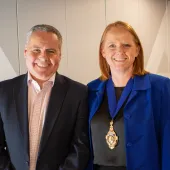CIOB highlights the role of clients in driving sustainable construction
Construction clients are committed to sustainable objectives, but cost and complexities hinder them, says a recent survey. This backs up mounting evidence from the Chartered Institute of Building’s (CIOB) recent client roundtables, suggesting a market failure and a need for greater policy support, writes Amanda Williams, CIOB's head of environmental sustainability.
Responsible consultants, contractors and suppliers to the construction industry invest a lot of time and effort into innovative strategies for making the built environment more sustainable. This is an important step to improving the multiple global threats addressed by the United Nation’s Sustainable Development Goals, including climate change, pollution, biodiversity loss, water scarcity, and social and financial inequality.
As committed as the supply-side is to these goals, though, the impact of their innovation will be limited without clients willing to adopt and pay for it.
And unfortunately, even though construction clients are themselves committed to sustainability, the complexity, risks and especially the extra cost of innovation frequently means it is rejected.
This frustrating situation, which looks increasingly like a market failure, has been a repeating theme in the series of sectoral roundtables run by CIOB as part of its ongoing Client Strategy investigating net zero challenges and opportunities with clients.
At a client CIOB roundtable at UKREIIF 2024, developers and real estate investors agreed while reaching for net zero was by now a mainstream ambition, they found it difficult to implement in practice, particularly for those who divest on completion. The problem, they said, is the viability of some green measures remain a significant obstacle.
In a bid to unlock progress, the Construction Leadership Council’s CO2nstruct Zero campaign called on infrastructure clients to act with the launch of Five Client Carbon Commitments – billed as practical steps organisations can take to show how they are reducing their carbon emissions and by when.
The Five Client Carbon Commitments are:
- Procure for low carbon construction and provide incentives in our contracts
- Set phase out dates for fossil fuel use
- Eliminate the most carbon intensive concrete products
- Eliminate the most carbon intensive steel products
- Adopt PAS 2080, Carbon Management in Infrastructure, as a common standard
It was unsurprising to see concrete at the centre of these commitments, given that it is the second most widely used material globally after water. It is often cited that if the cement industry were a country, it would be the world's third or fourth-largest emitter of carbon dioxide.
Construction clients can have a major role in driving growth in the use of low carbon concrete, by embedding appropriate requirements in their projects. But barriers cited include lack of knowledge about technical characteristics, higher costs, a lack of incentives, government policy gaps, and resistance to change.
The Breakthrough Agenda Report 2024, published in October, highlights the cement sector is not on track to meet net zero by 2050, with no substantive decline in global emissions over the past decade.
While an increasing number of projects for carbon capture and storage and other decarbonisation technologies are being announced, policy is not yet strong enough globally to drive the number and scale of projects needed across all major geographies.
The report goes on to update its recommendations under the Cement and Concrete Breakthrough Agenda, aimed at ensuring governments are playing their part in agreeing common standards, definitions and guidelines for cement and concrete production and use.
It aims to ensure governments are working collaboratively to coordinate and scale up early efforts to create a market for near-zero emission cement, and are accelerating policy support, the pace of learning, business case development, and practical technology collaboration partnerships.
The message is clear - Government must play a key role in driving demand for near zero or low emission concrete by setting standards, funding research, providing incentives, promoting collaboration and, as a significant construction client in its own right, embedding appropriate requirements in projects to upgrade public buildings and other infrastructure.
In a recent survey (by NBS in association with RIBA) of over 568 construction professionals, 11 per cent of which were construction clients.
Ninety-seven per cent of these clients stated their construction projects had sustainable outcome targets – more than any other group in the survey. What’s more, 88 per cent of clients said that they measured and reported on sustainability metrics for at least some projects. To top it off, 9 out of 10 clients – more so than other group – said that they set goals for reducing carbon footprint and to measure it.
Despite this willingness, these clients said they faced barriers, the biggest of which were cost and complexity.
If the construction sector is to do its bit to combat global threats, then these and many other structural challenges – notably the shortage of relevant skills – must also be overcome.
One of the striking results from both the NBS survey and CIOB’s client roundtables is the influence of policy support and regulation in addressing market failures.
It is no coincidence survey respondents said the most important sustainable outcome was net-zero operational carbon since, unlike embodied carbon, for example, it is covered by legislation.
This echoed views from the CIOB roundtables. For example, delegates at UKREIIF wanted much more ambition from government after hearing about Local Law 97 in New York, which is having extraordinary success in forcing through net zero measures despite some initial challenges.
A robust future homes and buildings standard, creation of a green skills fund, a commitment to addressing embodied carbon through a Part Z of the Building Regulations, and implementation of a national retrofit strategy could substantially accelerate progress.
Will the government listen and act? What’s clear is via its commitments to develop a new 10-year infrastructure strategy and build 1.5m homes in just five years, the new Labour government has the opportunity to make a significant difference. But will it rise to this challenge?
These are all issues we look forward to exploring in more detail at a CIOB net zero roundtable for clients in the transport and infrastructure sector in 2025.
CIOB’s technical guide on sustainability in the built environment is available online while a new guide to embodied carbon will be published in November this year.
CIOB also provides a range of free resources to support construction clients.








